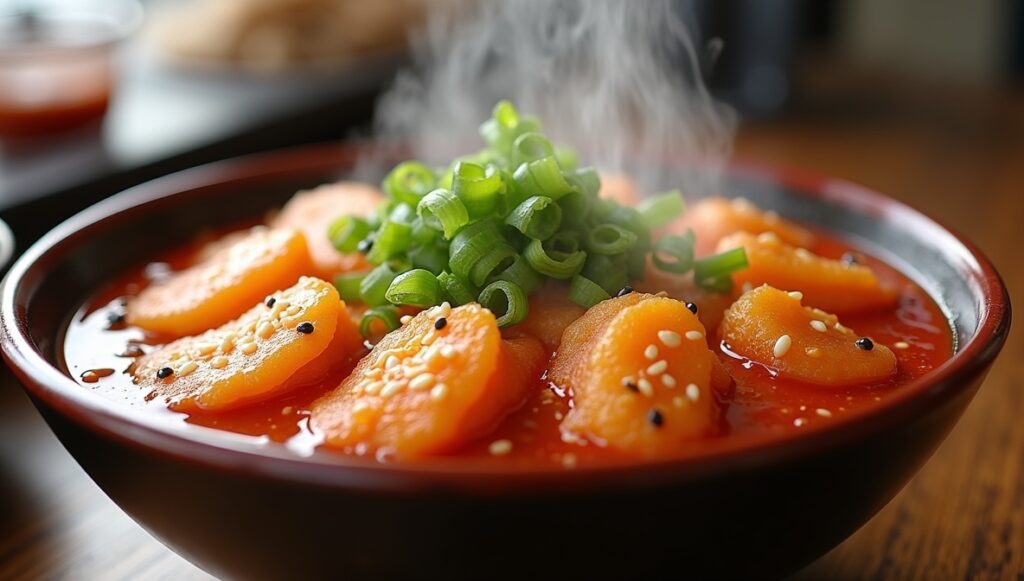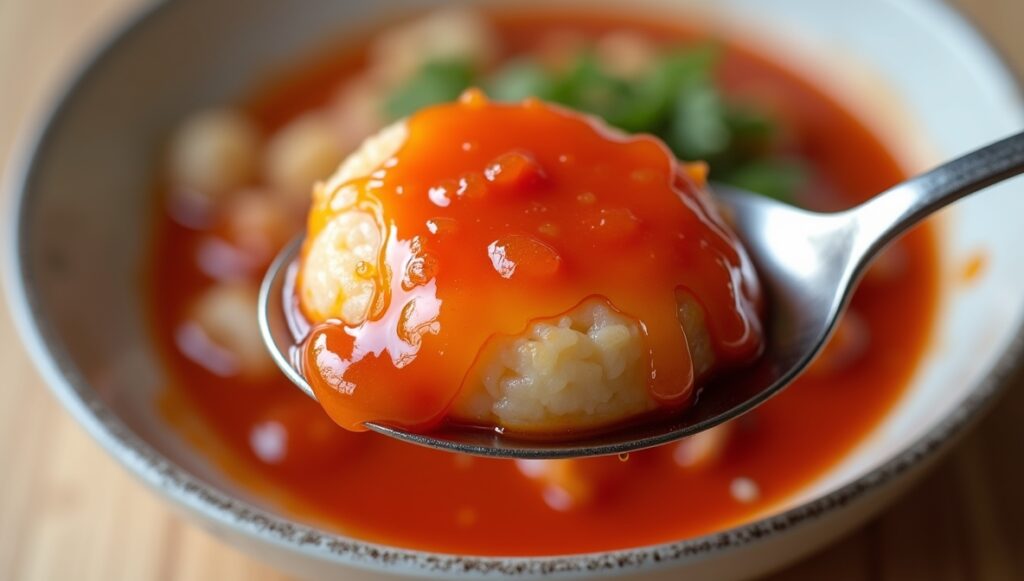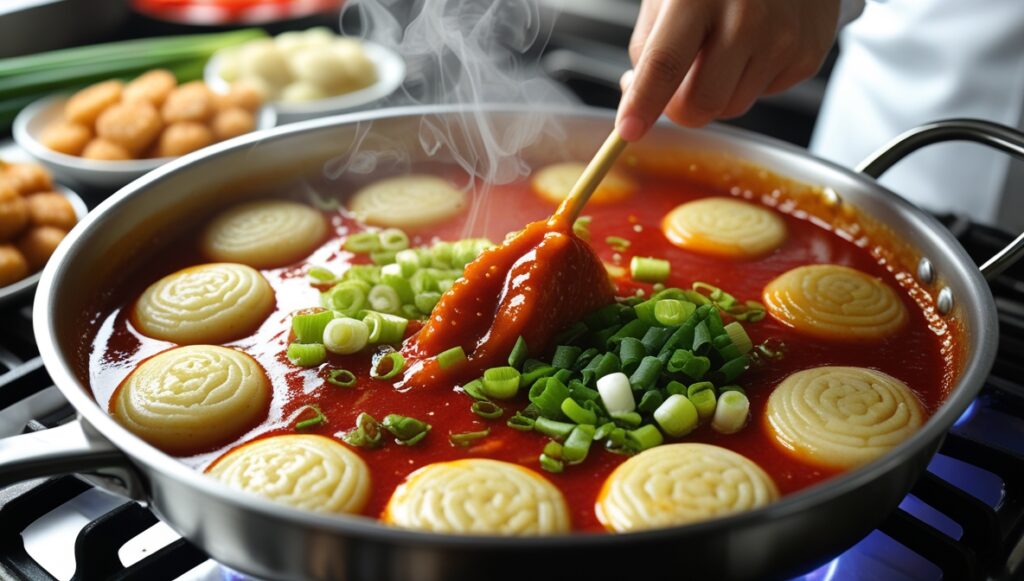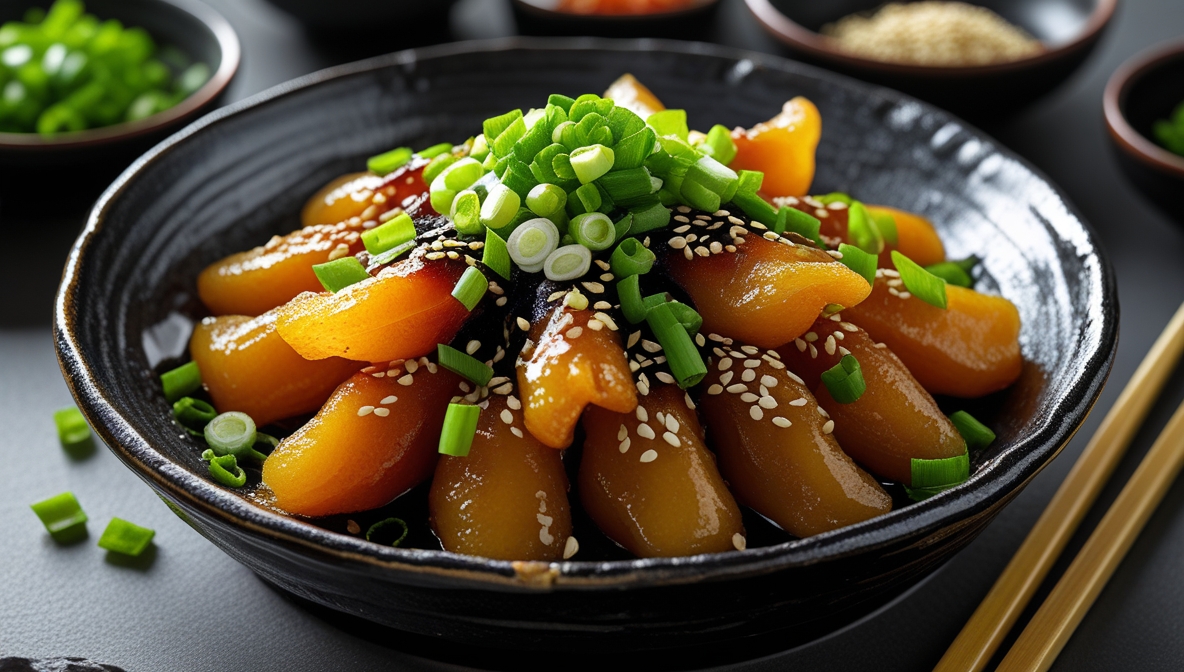Introduction
Tteokbokki (떡볶이), or “stir-fried rice cakes,” is one of the most cherished dishes in Traditional South Korea Food culture. These chewy rice cakes simmered in a vibrant, spicy-sweet gochujang (chili paste) sauce have become a go-to meal for everyone—from school kids to seasoned food lovers. This dish represents more than just flavor—it’s a sensory journey that reflects the heart of Korean street food.
Whether you’re wandering through Seoul’s street food alleys or experimenting with the Best Recipe in your kitchen, the experience is unforgettable. Often featured in lists of the Famous Foods in South Korea, this dish has also evolved into numerous regional and international adaptations.


History & Cultural Significance
What began as a dish served to royalty has now become a national treasure. The original version, Gungjung Tteokbokki, dates back to the Joseon Dynasty. Unlike the fiery version we know today, it was soy sauce-based and included beef and seasonal vegetables.
The spicy transformation took place in the 1950s, when gochujang was introduced to the recipe, giving rise to the street food we love today. From palace kitchens to roadside carts, this food embodies the evolution of Traditional South Korea Food, blending history with contemporary flavor.
Ingredients & Regional Variations
To create the Best Tteokbokki Recipe, the following ingredients are typically used:
Garae-tteok (Korean cylindrical rice cakes)
Gochujang (Korean red pepper paste)
Gochugaru (chili flakes)
Fish cakes (eomuk)
Cabbage, onions, scallions
Soy sauce, garlic, sugar
Regional & Fusion Styles:
Gungjung style: Mild, soy-based, no spice
Cheese style: Rich and creamy, topped with melted cheese
Seafood variation: Includes shrimp, squid, or mussels
Rose version: Cream or milk added for a smooth, mellow kick
These styles highlight why it remains one of the most Famous Foods in South Korea, adaptable for every taste and dietary need.
Cooking Process & Difficulty Level

Creating this dish at home is surprisingly beginner-friendly, and the Best Tteokbokki Recipe involves just a few simple steps:
Prepare a broth using anchovies and kelp
Mix gochujang, soy sauce, sugar, and minced garlic
Add rice cakes, fish cakes, and vegetables into the broth
Simmer until thickened and the rice cakes become tender
Finish with sesame oil and scallions for garnish
This process delivers an authentic taste of Traditional South Korea Food right in your kitchen.
Where to Eat Tteokbokki
Curious about Best Place to Try Tteokbokki in Korea? Some of the top local spots include:
Seoul:
Mabongnim Tteokbokki: Serving loyal customers since 1953
Dongdaemun Yupdduk: Notorious for its spicy heat
Ttobogetji: Known for its layered, complex flavors
Busan:
Gukje Market: A haven for regional versions of Famous Foods in South Korea
Travelers abroad can find it at Korean restaurants or cultural food festivals, which are often the best places Where to Eat Tteokbokki outside Korea.
What to Eat with It
Drinks:
Soju: A traditional Korean spirit
Makgeolli: A sweet, milky rice wine
Sikhye: A chilled rice dessert drink
Side Dishes:
Kimchi: Spicy fermented cabbage
Eomuk Soup: Warm broth with fish cakes
Twigim: Deep-fried vegetables and seafood
These pairings balance the spice and enhance the overall meal experience.
Fun Facts
The name is a combination of “tteok” (rice cake) and “bokki” (stir-fried). Once served at royal banquets, it has grown into a street food favorite and a fixture among Famous Foods in South Korea. Creative twists like carbonara or pizza versions show just how far this dish has traveled in the culinary world.
Nutrition & Dietary Tips
The dish is primarily high in carbohydrates, offering energy and a spicy kick from gochujang, which contains metabolism-boosting capsaicin. Adjustments can be made for various diets:
Vegan: Omit fish cakes
Gluten-free: Use certified GF gochujang and soy sauce
Low-carb: Substitute rice cakes with konjac or tofu noodles
Best Tteokbokki Recipe (Make it at Home)
Ingredients:
2 cups garae-tteok
1.5 cups water
2 tbsp gochujang
1 tbsp soy sauce
1 tbsp sugar
1 tsp minced garlic
½ cup fish cakes, cabbage, onions
Sesame oil, scallions, sesame seeds
Instructions:
Soak rice cakes in warm water
Prepare sauce by mixing gochujang, soy, sugar, and garlic
Boil water, add all ingredients
Simmer until thickened
Garnish and serve
It’s one of the easiest ways to enjoy Traditional South Korea Food at home.
Global Popularity
Thanks to the global spread of Korean pop culture (Hallyu), this dish has found fans worldwide. It now appears in cross-cultural recipes like tacos, pasta, and even sushi rolls, securing its place among the most Famous Foods in South Korea and beyond.
Tteokbokki vs. Similar Dishes
Tteokbokki (Korea)
Main Ingredient: Cylindrical rice cakes (tteok)
Sauce Base: Gochujang (spicy red chili paste)
Flavor Profile: Spicy, sweet, savory
Texture: Chewy and soft
Common Additions: Fish cakes, boiled eggs, cabbage
Typical Setting: Korean street food, home cooking
Spaghetti Arrabbiata (Italy)
Main Ingredient: Wheat spaghetti
Sauce Base: Garlic, olive oil, red chili, tomatoes
Flavor Profile: Spicy, tangy
Texture: Al dente pasta
Common Additions: Parsley, Parmesan cheese
Typical Setting: Italian restaurants, home dining
Pad Thai (Thailand)
Main Ingredient: Flat rice noodles
Sauce Base: Tamarind, fish sauce, palm sugar
Flavor Profile: Sweet, sour, umami, nutty
Texture: Stir-fried with a light chew
Common Additions: Shrimp, tofu, peanuts, bean sprouts
Typical Setting: Thai street food, fast casual dining
Curry Rice Cakes (Korea – Fusion)
Main Ingredient: Rice cakes
Sauce Base: Korean curry roux
Flavor Profile: Mildly spicy, earthy
Texture: Chewy rice cakes in thick curry
Common Additions: Vegetables, sausages
Typical Setting: Korean home cooking, fast food chains
Mac and Cheese (USA)
Main Ingredient: Elbow macaroni
Sauce Base: Cheese (typically cheddar), milk, butter
Flavor Profile: Creamy, salty, cheesy
Texture: Soft, rich
Common Additions: Breadcrumb topping, bacon
Typical Setting: Comfort food, school lunches, casual dining

